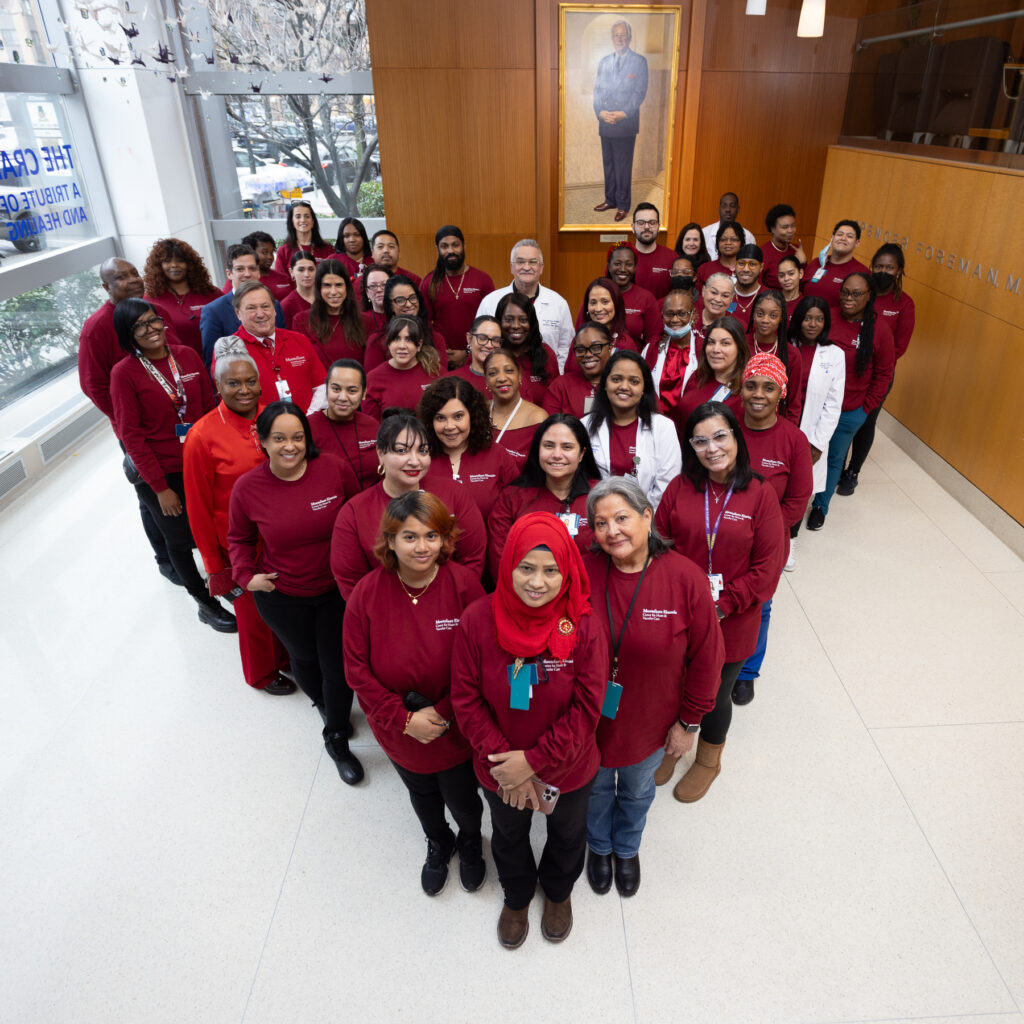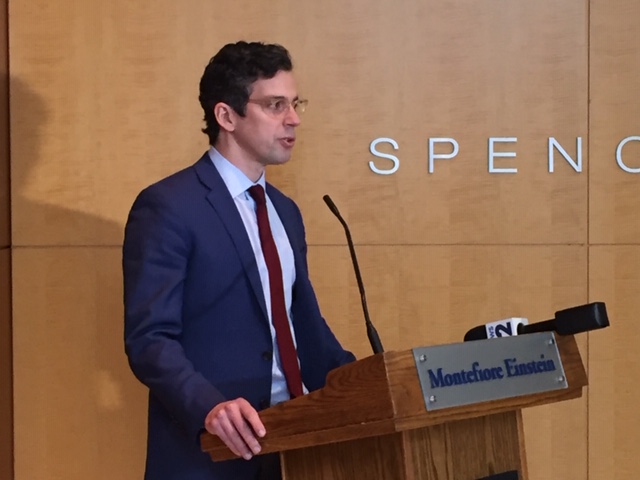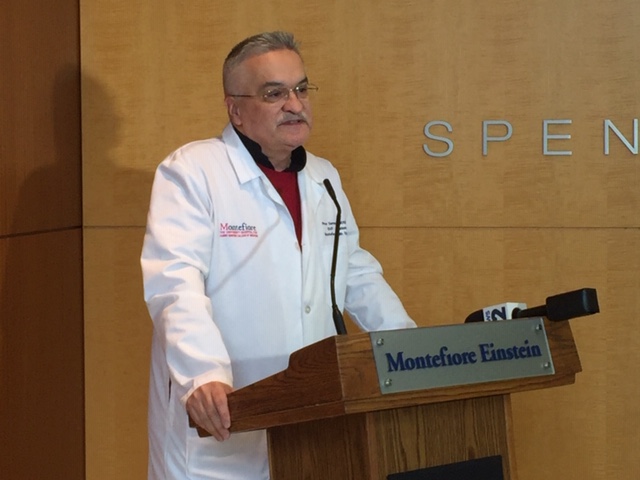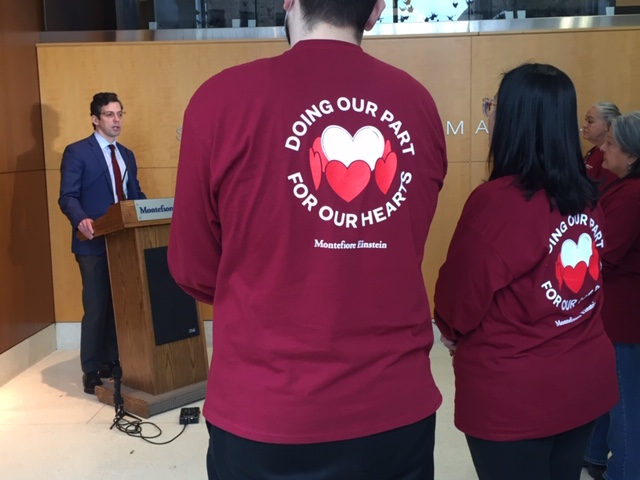
Photo courtesy of Lori Adams
Heart disease is preventable, yet it is the leading cause of death in the United States according to the National Heart, Lung & Blood Institute (NHLBI) with more than 800,000 people dying of cardiovascular disease every year. Despite this, a recent poll conducted by Harris and the American Heart Association found that more than half of U.S. residents are unaware of these facts.
In recognition of National Wear Red Day, and to kick off American Heart Month in February, cardiology specialists, medical teams, and administrators at Montefiore Health System, dressed in red and gathered at its 210th Street Moses campus in Norwood for an event on Friday, Feb. 2, to raise awareness and share information about the signs and symptoms of, and treatments for, heart disease.
Dr. Leandro N. Slipczuk Bustamente, section chief of general cardiology at Montefiore, said, “Heart disease is very common. We usually think of a middle-aged man or older who gets heart disease, but we know that’s not true. We know that patients who are younger are at risk, women are at risk, and we know that minorities are at risk.”

Photo by Síle Moloney
Slipczuk continued, “All of these groups of patients, when they have symptoms, don’t usually go to a doctor, and many times when they do go to a doctor, the doctors may not think they have heart disease. So, it’s very important to take a proactive approach to controlling the risk factors.”
Slipczuk said these factors include high cholesterol, high blood pressure, diabetes, obesity, exercise, diet, and smoking. “If you control all those risk factors, you have a lot less chance of developing heart disease, and it’s a lot easier to control early on,” he said.
Women in particular are at great risk when it comes to heart disease. According to the Center for Disease Control and Prevention (CDC), over 60 million women in the United States (44%) live with some form of heart disease. CDC officials also say heart disease is the leading cause of death for women in the United States, and in 2021, it was responsible for around one in every five female deaths.

Photo courtesy of Cedars-Sinai.
Peter P. Semczuk, senior vice president of clinical services and executive director at Montefiore’s Moses campus, said, “Cardiovascular disease is the number one killer of women and men in this country. It turns out that when a woman has a heart attack, she’s twice as likely to die than a man, and that really saddens me, because of knowing the types of advanced diagnostics that we have available.”
Grammy and Academy Award-winning singer-songwriter, actor, producer, and director, Barbra Streisand, has long been outspoken in her efforts to raise awareness about heart disease in women. In 2008, she helped raise $22 million for the cause, including a personal donation of $10 million to the Women’s Heart Center at Cedar Sinai Medical Center in Los Angeles.
“I think women are embarrassed to talk about heart disease because there is a stigma attached to it,” Streisand said during a prior lecture at the National Institute of Health. “It is known as an old man’s disease in a sense, so many people think it just affects older men, but that is not true.”

Photo by Síle Moloney
Indeed, heart disease has been on the rise for decades. A study by the World Heart Federation found that deaths from cardiovascular disease jumped globally from 12.1 million in 1990, to 20.5 million in 2021.
“So, there’s a recent increase in cardiovascular disease,” said Slipczuk. “We have about 50 percent of people when they [are] over 20 years of age, that have some sort of cardiovascular disease. We know that this is mainly due to hypertension, and we think these trends are, in part, because of the lack of control of risk factors,” he said.
Meanwhile, according to the organization goredforwomen.org, while one in 31 American women dies from breast cancer each year, heart disease is the cause of one out of every three deaths in American women. Streisand has highlighted that despite this, much of the research on heart disease has traditionally focused on men.

Photo by Síle Moloney
During the event, important information about prevention and management of heart disease, through a healthy diet and exercise, was discussed. To reduce the risk of heart disease, Slipczuk emphasized the importance of monitoring key health indicators and adopting a nutritious diet, while Semczuk underscored the significance of listening to one’s body and taking prompt action if any abnormalities are detected.
“So, what can you do? Check your blood cholesterol, check your blood pressure, check your blood sugar, and if they are high, please go to a cardiologist,” he said. “Go to your PCP and get it treated. You should eat a healthy diet full of vegetables and fruits, and try to avoid ultra-processed foods,” he added.
Meanwhile, addressing those gathered, Semczuk concluded, “You know your bodies better than anybody, and if there’s something that just doesn’t feel right, do something about it.”
Read our latest regular Health Check feature here.




